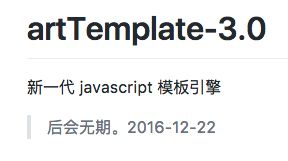前言
因为工作的关系,我在接手项目的时候发现以前的同事都是用 artTemplate 进行模板渲染的。鉴于它方便用于 Ajax 请求数据并渲染的操作并在项目应用颇多,所以在我开发新的项目时,也把其作为一个主要的 library 插件,同时利用 gulp 进行 artTemplate 的预编译。下面就是我在新项目的使用过程中遇到的问题总结出来的经验以及 artTemplate 的使用方法,以供参考。
1. artTemplate介绍
一个渲染性能出众模板引擎,无论在 NodeJS 还是在浏览器中都可以运行。
- GitHub地址
- 文档地址
特性
- 拥有接近 JavaScript 渲染极限的的性能
- 调试友好:语法、运行时错误日志精确到模板所在行;支持在模板文件上打断点(Webpack Loader)
- 支持压缩输出页面中的 HTML、CSS、JS 代码
- 支持 Express、Koa、Webpack
- 支持模板继承与子模板
- 兼容 EJS、Underscore、LoDash 模板语法
- 模板编译后的代码支持在严格模式下运行
- 支持 JavaScript 语句与模板语法混合书写
- 支持自定义模板的语法解析规则
- 浏览器版本仅 6KB 大小
简单来说就是把以前你通过字符串拼接,再用 js append 到 dom 然后再填充数据的方式转变为另外一种便于阅读,代码优雅,性能更快的模板引擎。
2. artTemplate版本问题
因为在工作中遇到一些问题,在上网查文档的时候发现怎么 artTemplate 会有两个:
artTemplate
你在百度搜索时,第一个应该是 jQuery 插件库网站上介绍的 artTemplate-3.0 (这个也是本司原项目使用的版本),但是你会发现怎么很多链接都报 404 根本没使用。只好上 GitHub 上搜索,第一条的是 lhywork/artTemplate 链接还是 404 ,而且 Stars 数量这么少让我一度怀疑这个项目是不是报废了,因为我看到网上说作者停止维护该项目的信息。art-template
在漫无目的的搜索后,我又发现一个叫 art-template 的库,上面的写法跟 artTemplate 差不多,但我在用辅助方法时却发现,原项目中的过滤器:
template.helper(name, callback)
不能用了,现在变成了
template.defaults.imports.dateFormat = function(date, format){/*[code..]*/};
一度以为这是两个不同的项目,导致我只能通过别人的博客寻找解决项目问题的方法。
直到我空下来说研究一下这个 art-template 并想找到 artTemplate 的作者询问些问题(因为在 gulp 预编译 artTemplate 的过程中出现了一个大坑),才发现原来两个作者都是同一个人,这位叫 糖饼 的大哥,一位爱改名字且爱删东西的大哥。
在短短几个月后他又发现 artTemplate 并没有被市面上的 dom模板所彻底打败,它依然有所作为,所以他又开发了一个新的版本并改名为 art-template。同时 Branch 下的 3.1.0 README.md 文档中的链接已经失效了( 他删掉了 ),这极大的不方便接手别人项目的同学学习。不过可以在 dist 与 demo 再次取得部分的资料。
下面我将对这两个版本一些要点进行说明与记录,并且只进行简洁语法说明,方便以后大家使用。
3. artTemplate - 3.0
这个版本应该是目前应用最多的,其有以下五种使用方法,
a. 浏览器版本
直接引入 template.js 文件,下面示例代码中将包含:
- 基础使用 - script 标签用法
- 不转义 html 方法
- 打印 - {{print}}
- 过滤器 - template.help
- debug
- 模板外置
- 模板嵌套 - 子模板(include)
demo-index.html - 基本 API 用法
浏览器版本-demo
//引入 template.js
compile.js - 模板外置方法
/**
大量页面希望引入同一个模板时,不可能每个页面都添加相同的
//然后我们再通过
// rel = "import" 可能存在兼容问题,低版本的浏览器慎用。
include.html - 模板嵌套代码
b. NodeJS 应用
当你想在 Node 环境下运用 artTemplate 时,可以采用下面的方法:
安装
$ cnpm install [email protected]
因为现在 art-template 已经是开发到 4.12.1 了所以想要兼容上一个版本的 artTemplate 需要下载对应版本的 npm 插件。
ps. 想查看某个插件含有多少的版本可以敲以下命令
$ cnpm view art-template versions
使用
var template = require('art-template');
var data = {list: ["aui", "test"]};
var html = template(__dirname + '/index/main', data);
ps. 更多配置与详情自行查看 GitHub 说明
接下来就是预编译模式,其意思是默认将整个目录的模板(html文件)压缩打包到一个名为 template.js 的脚本中,并无需引用浏览器版本的 template.js ,可直接在页面中使用它:
c. node工具 - tmodjs
安装
$ cnpm install -g tmodjs
编译
tmod [模板目录] [配置参数] [模板输出目录]
示例:$ tmod ./tpl --output ./build
配置参数
| 插件 | 介绍 |
|---|---|
| --debug | 输出调试版本 |
| --charset value | 定义模板编码,默认utf-8 |
| --output value | 定义输出目录,默认./build |
| --type value | 定义输出模块格式,默认default,可选cmd、amd、commonjs |
| --no-watch | 关闭模板目录监控 |
| --version | 显示版本号 |
| --help | 显示帮助信息 |
插件配置
插件的配置则是写在 package.json 文件中:
{
"name": "template",
"version": "1.0.0",
"dependencies": {
"tmodjs": "1.0.0"
},
"tmodjs-config": {
"output": "./build",
"charset": "utf-8",
"syntax": "simple",
"helpers": null,
"escape": true,
"compress": true,
"type": "default",
"runtime": "template.js",
"combo": true,
"minify": true,
"cache": false
}
}
| 字段 | 类型 | 默认值 | 说明 |
|---|---|---|---|
| output | String | "./build" | 编译输出目录设置。如果设置为 false 则不输出 |
| charset | String | "utf-8" | 模板使用的编码(暂时只支持 utf-8) |
| syntax | String | "simple" | 定义模板采用哪种语法。可选:simple、native |
| helpers | String | null | 自定义辅助方法路径 |
| escape | Boolean | true | 是否过滤 XSS。如果后台给出的数据已经进行了 XSS 过滤,就可以关闭模板的过滤以提升模板渲染效率 |
| compress | Boolean | true | 是否压缩 HTML 多余空白字符 |
| type | String | "default" | 输出的模块类型,可选:default、cmd、amd、commonjs |
| runtime | String | "template.js" | 设置输出的运行时名称 |
| alias | String | null | 设置模块依赖的运行时路径(仅针对于非default的类型模块配置字段。如果不指定模块内部会自动使用相对 runtime 的路径) |
| combo | Boolean | true | 是否合并模板(仅针对于 default 类型的模块) |
| minify | Boolean | true | 是否输出为压缩的格式 |
| cache | Boolean | true | 是否开启编译缓存 |
| verbose | Boolean | true | 是否打印日志 |
d. Grunt插件 - grunt-tmod
由 @Jsonzhang 开发
安装
$ cnpm install grunt-tmod --save-dev
//加载插件
grunt.loadNpmTasks('grunt-tmod');
使用
module.exports = function(grunt){
grunt.initConfig({
tmod: {
template: {
src: './tpl/**/*.html',
dest: './dist/template.js',
options: {
combo: true,
base: './tpl/src' // 这个什么意思看下面的 Gulp 说明,很重要
}
}
}
});
grunt.loadNpmTasks('grunt-tmod');
grunt.registerTask('default', ['tmod']);
};
//更多查看 GitHub 项目地址
e. Gulp插件 - gulp-tmod
由 @lichunqiang 开发
安装
$ cnpm install gulp-tmod --save-dev
使用
var tmodjs = require('gulp-tmod');
//编译功能代码
gulp.task('art', function() {
var stream = gulp.src(src.common.template)
.pipe(tmod({
templateBase: 'app/src/common/template'
}))
.pipe(gulp.dest(dist.common.template));
console.log("artTemplate编译完成!");
return stream;
});
由于本人目前就是采用该方法,所以理解较深,使用过程中有几点的需要注意的问题稍微跟大家提及一下,其他方法也可以参照使用:
- templateBase
这里的 templateBase 是替换掉生成的 template.js 文件中模板ID的,比如我们的模板是 “app/src/common/template/demo.html” ,这时候引用改模板是这样使用的
//默认去掉 .html 后缀
var html = template('app/src/common/template/demo', data);
document.getElementById('content').innerHTML = html;
当我们设置了 base 值
.pipe(tmod({
templateBase: 'app/src/common/template'
}))
// 引用时只需要
var html = template('demo', data);
document.getElementById('content').innerHTML = html;
- 监察的写法
利用 Gulp 的 watch API
//artTemplate
var watcherArt = gulp.watch('app/src/common/template/**/**.html', ['art']);
watcherArt.on('change', function(event) {
console.log('该模板 ' + event.path + ' was ' + event.type + ', 执行artTemplate编译...');
});
- 当编译完成后,template.js 却没有任何改变 ( 绝对重点 )
这个是很危险的一个坑,它不会在控制台中输出 bug ,而是正常的完成编译。让你一直以为是插件,还是环境什么的问题,这曾经浪费我大量的时间找 bug 。后来有一个报 bug 的文件一闪而过,我到现在都不知道它是在什么情况下才会生成。
不过你只要记住!它编译后没改变文件的原因只有一个,就是你丫的模板 html
的语法写错了!
重新检查一下,再次编译吧!
ps. 模板的 html 文件就是简单的 dom 不需要干别的事情,例:
{{title}}
{{data}}
我看这篇幅已经很长了,所以决定分为上下两篇~
下篇《 前端模版引擎 - art-template【下】》
该篇收录于文集:前端技术栈

